
In mythology, folklore and speculative fiction, shapeshifting is the ability to physically transform oneself through an inherently superhuman ability, divine intervention, demonic manipulation, sorcery, spells or having inherited the ability. The idea of shapeshifting is in the oldest forms of totemism and shamanism, as well as the oldest existent literature and epic poems such as the Epic of Gilgamesh and the Iliad. The concept remains a common literary device in modern fantasy, children's literature and popular culture.

"Ancient astronauts" refers to a pseudoscientific hypothesis, that intelligent extraterrestrial beings visited Earth and made contact with humans in antiquity and prehistoric times. Proponents suggest that this contact influenced the development of modern cultures, technologies, religions, and human biology. A common position is that deities from most, if not all, religions are extraterrestrial in origin, and that advanced technologies brought to Earth by ancient astronauts were interpreted as evidence of divine status by early humans.

Croagh Patrick, nicknamed 'the Reek', is a mountain with a height of 764 m (2,507 ft) and an important site of pilgrimage in County Mayo, Ireland. The mountain has a pyramid-shaped peak and overlooks Clew Bay, rising above the village of Murrisk, several miles from Westport. It has long been seen as a holy mountain. It was the focus of a prehistoric ritual landscape, and later became associated with Saint Patrick, who is said to have spent forty days fasting on the summit. There has been a church on the summit since the 5th century; the current church dates to the early 20th century. Croagh Patrick is climbed by thousands of pilgrims every year on Reek Sunday, the last Sunday in July, a custom which goes back to at least the Middle Ages.

The Majipoor series is a series of novels and stories by American writer Robert Silverberg, set on the planet Majipoor. The setting is a mixture of science fiction and fantasy elements.

Reek Sunday or Garland Sunday is an annual day of pilgrimage in Ireland. On the last Sunday in July, thousands of pilgrims climb Ireland's holiest mountain, Croagh Patrick in County Mayo. It is held in honour of Saint Patrick who is said to have spent forty days fasting on the mountain in the 5th century. Masses are held at the summit, where there is a small chapel. Some climb the mountain barefoot, as an act of penance, and some carry out 'rounding rituals', which were formerly a key part of the pilgrimage. This involves praying while walking sunwise around features on the mountain: seven times around the cairn of Leacht Benáin, fifteen times around the circular perimeter of the summit, seven times around Leaba Phádraig, and then seven times around three ancient burial cairns known as Reilig Mhuire. Until 1970, it was traditional for pilgrims to climb the mountain after sunset.

Gordon Randall Phillip David Garrett was an American science fiction and fantasy author. He was a contributor to Astounding and other science fiction magazines of the 1950s and 1960s. He instructed Robert Silverberg in the techniques of selling large quantities of action-adventure science fiction, and collaborated with him on two novels about men from Earth disrupting a peaceful agrarian civilization on an alien planet.

The Fall of Hyperion is the second novel in the Hyperion Cantos, a science fiction series by American author Dan Simmons. The novel, written in 1990, won both the 1991 British Science Fiction and Locus Awards. It was also nominated for the Hugo Award and the Nebula Award.
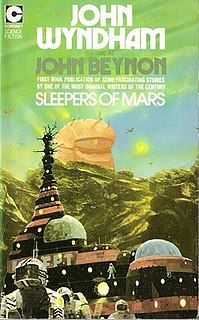
Sleepers of Mars is a collection of early short stories by British writer John Wyndham, published after his death, in 1973 by Coronet Books.

Hyperion is a 1989 science fiction novel by American author Dan Simmons. The first book of his Hyperion Cantos, it won the Hugo Award for best novel.

The Man in the Maze is a science fiction novel by American writer Robert Silverberg, originally serialized in the magazine, Worlds of If April in May 1968, and published in bookstores the following year. It tells the tale of a man rendered incapable of interacting normally with other human beings by his uncontrollable psychic abilities. The novel is inspired by Sophocles' play Philoctetes, with the roles of Odysseus, Neoptolemus and Philoctetes played by Boardman, Rawlins, and Muller, respectively.

First contact is a common science fiction theme about the first meeting between humans and extraterrestrial life, or of any sentient species' first encounter with another one, given they are from different planets or natural satellites. The theme allows writers to explore such topics such as xenophobia, transcendentalism, and basic linguistics by adapting the anthropological topic of first contact to extraterrestrial cultures.

In science fiction and in the beliefs of ufology, a Venusian or Venerian is a native inhabitant of the planet Venus. Many science fiction writers have imagined what extraterrestrial life on Venus might be like.
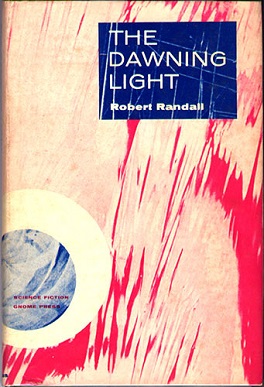
The Dawning Light is a 1959 science fiction novel published under the name Robert Randall, collaborative pseudonym of American writers Robert Silverberg and Randall Garrett. It depicts the changes, after the events of The Shrouded Planet by the same authors, in the society of the fictional planet Nidor, a world perpetually covered in dense cloud, inhabited by humanoids resembling humans but differing in several respects, notably in being covered from head to foot in short downy fur. The technological level of the society is about that of Renaissance Europe, and has been that way for thousands of years.

The Shrouded Planet is a 1957 science fiction novel published under the name "Robert Randall", actually the collaborative work of American writers Robert Silverberg and Randall Garrett. It consists of three linked stories, each originally published separately in the magazine Astounding Science Fiction. Linking chapters were added for book release. The first book printing, by Gnome Press in New York, was small and did not sell well. This and the sequel novel, The Dawning Light, were reprinted 25 years later.
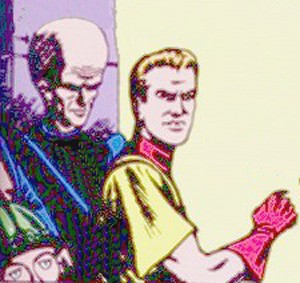
Chris KL-99 is a 1950s science fiction comic book character whose adventures were published by National Comics, now known as DC Comics. He first appeared in Strange Adventures #1, and was created by science fiction author Edmond Hamilton and artist Howard Sherman.
"Valley of Dreams" is a science fiction short story by American writer Stanley G. Weinbaum originally published in the November 1934 issue of Wonder Stories. "Valley of Dreams" was Weinbaum's second published story, and is a sequel to his first story, "A Martian Odyssey".
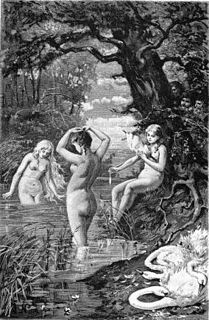
Therianthropy is the mythological ability of human beings to metamorphose into other animals by means of shapeshifting. It is possible that cave drawings found at Les Trois Frères, in France, depict ancient beliefs in the concept. The best-known form of therianthropy is found in stories of werewolves.
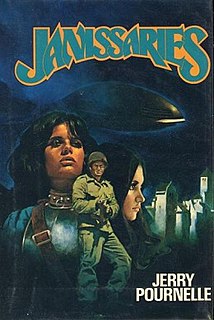
Janissaries is a science fiction novel by American author Jerry Pournelle. Originally published in 1979, and illustrated by comic artist Luis Bermejo, it is the first book of Pournelle's Janissaries series. The following books are Janissaries: Clan and Crown, Janissaries III: Storms of Victory and Janissaries IV: Mamelukes.

Flight to Mars is a 1951 American Cinecolor science fiction film drama, produced by Walter Mirisch for Monogram Pictures, directed by Lesley Selander, that stars Marguerite Chapman, Cameron Mitchell, and Arthur Franz.
Ancient astronauts have been addressed frequently in science fiction and horror fiction. Occurrences in the genres include:



















